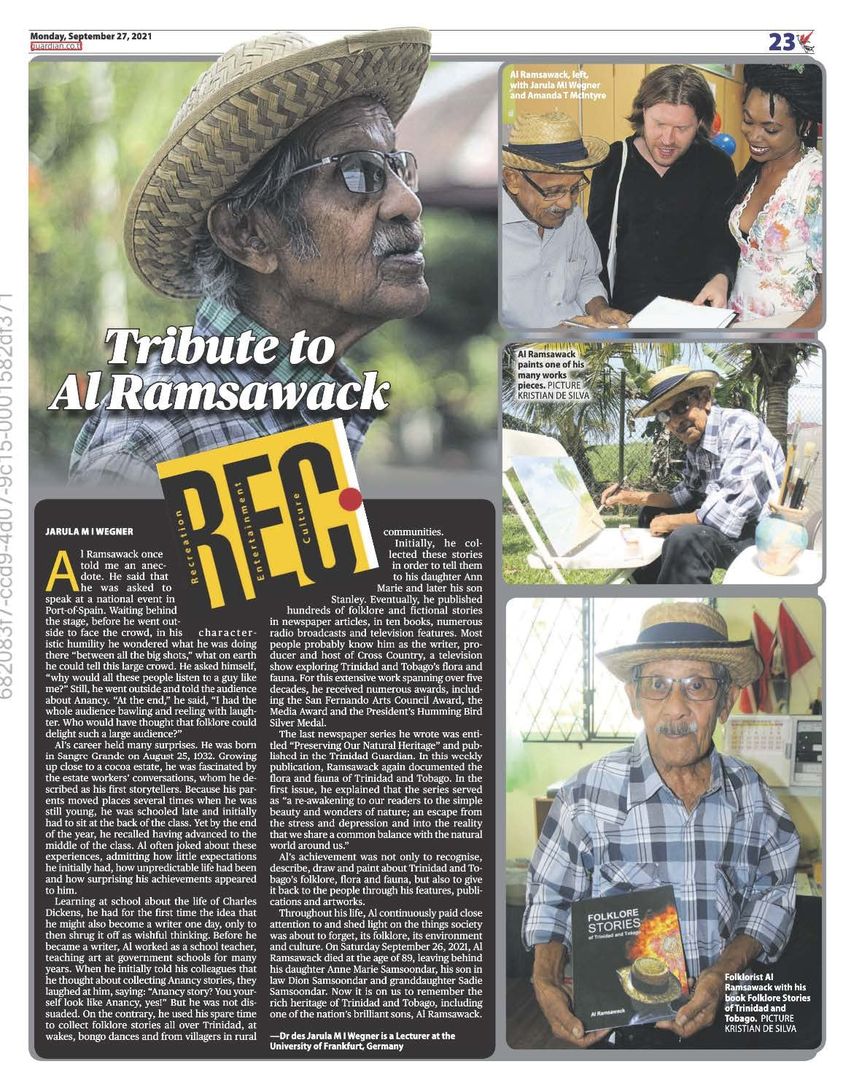|
Al Ramsawack once told me an anecdote. He said that he was asked to speak at a national event in Port of Spain. Waiting behind the stage, before he went outside to face the crowd, in his characteristic humility he wondered what he was doing there “between all the big shots,” what on earth he could tell this large crowd. He asked himself, “why would all these people listen to a guy like me?” Still, he went outside and told the audience about Anancy. “At the end,” he said, “I had the whole audience bawling and reeling with laughter. Who would have thought that folklore could delight such a large audience?” Al’s career held many surprises. He was born in Sangre Grande on 25 August 1932. Growing up close to a cocoa estate, he was fascinated by the estate workers’ conversations, whom he described as his first storytellers. Because his parents moved places several times when he was still young, he was schooled late and initially had to sit at the back of the class. Yet by the end of the year, he recalled having advanced to the middle of the class. Al often joked about these experiences, admitting how little expectations he initially had, how unpredictable life had been and how surprising his achievements appeared to him. Learning at school about the life of Charles Dickens, he had for the first time the idea that he might also become a writer one day, only to then shrug it off as wishful thinking. Before he became a writer, Al worked as a school teacher, teaching art at government schools for many years. When he initially told his colleagues that he thought about collecting Anancy stories, they laughed at him, saying: “Anancy story? You yourself look like Anancy, yes!” But he was not dissuaded. On the contrary, he used his spare time to collect folklore stories all over Trinidad, at wakes, bongo dances and from villagers in rural communities. Initially, he collected these stories in order to tell them to his daughter Ann Marie and later his son Stanley. Eventually, he published hundreds of folklore and fictional stories in newspaper articles, in ten books, numerous radio broadcasts and television features. Most people probably know him as the writer, producer and host of Cross Country, a television show exploring Trinidad and Tobago’s flora and fauna. For this extensive work spanning over five decades, he received numerous awards, including the San Fernando Arts Council Award, the Media Award and the President’s Humming Bird Silver Medal. The last newspaper series he wrote was entitled “Preserving Our Natural Heritage” and published in the Trinidad Guardian. In this weekly publication, Ramsawack again documented the flora and fauna of Trinidad and Tobago. In the first issue, he explained that the series served as “a re-awakening to our readers to the simple beauty and wonders of nature; an escape from the stress and depression and into the reality that we share a common balance with the natural world around us.” Al’s achievement was not only to recognise, describe, draw and paint about Trinidad and Tobago’s folklore, flora and fauna, but also to give it back to the people through his features, publications and artworks. Throughout his life, Al continuously paid close attention to and shed light on the things society was about to forget, its folklore, its environment and culture. On Saturday, 26 September 2021, Al Ramsawack died at the age of 89, leaving behind his daughter Anne Marie Samsoondar, his son in law Dion Samsoondar and granddaughter Sadie Samsoondar. Now it is on us to remember the rich heritage of Trinidad and Tobago, including one of the nation’s brilliant sons, Al Ramsawack. (Source: Virtual Museum of TT, Sept 30, 2021)
0 Comments
Leave a Reply. |
T&T news blogThe intent of this blog is to bring some news from home and other fun items. If you enjoy what you read, please leave us a comment.. Archives
July 2025
Categories
All
|


 RSS Feed
RSS Feed